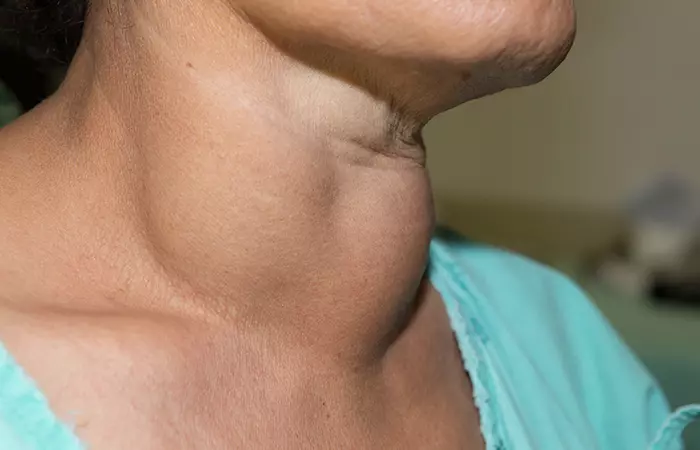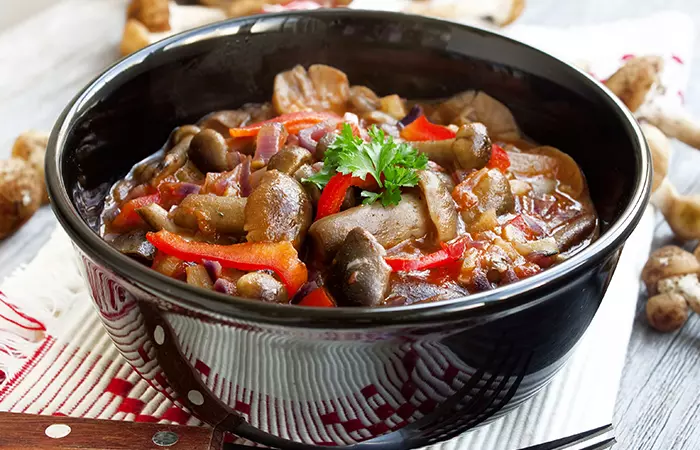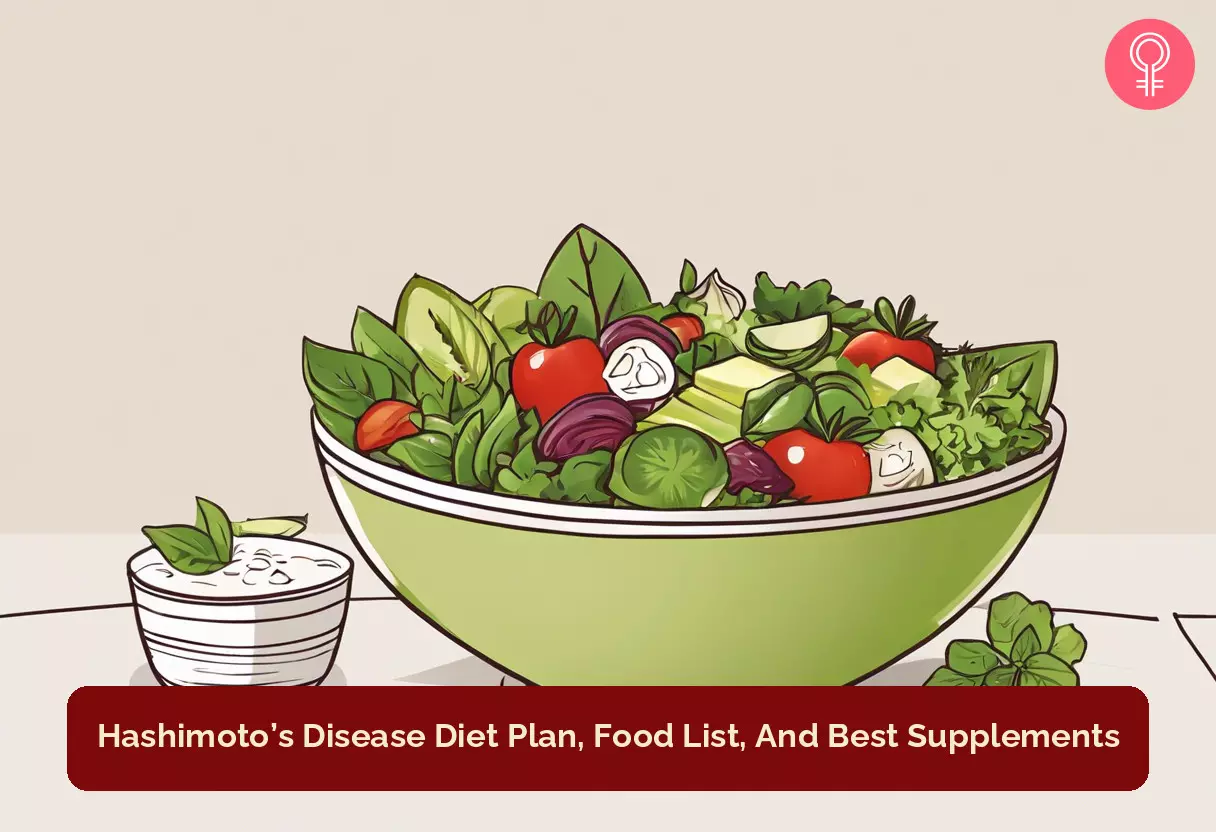People with Hashimoto’s thyroiditis are often at risk of developing other conditions such as hypothyroidism, hypertension, and cardiac diseases. A gluten-free, anti-inflammatory nutritious diet supports your metabolism, prevents inflammation, improves gut health, and aids thyroid functions. Keep reading to learn about the best diet plans for Hashimoto’s disease and recipes to manage your condition naturally.
What Is Hashimoto’s Disease?
It is a condition in which a dysfunctional immune system attacks the body’s thyroid cells, thus impairing the thyroid gland, which regulates the body’s metabolic, cardiac, and developmental activities, from producing adequate amounts of thyroid hormones. This may lead to hypothyroidism and, rarely, to hyperthyroidism (1). Hashimoto’s disease may also increase the risk of cardiovascular diseases and other bodily conditions (2). According to studies, Hashimoto’s disease is more common among middle-aged women (30 to 50 years) than in men (1). Being an autoimmune disease, those with a family history of the condition are more likely to develop Hashimoto’s thyroiditis.
Symptoms Of Hashimoto’s Thyroiditis
A goiter (enlarged thyroid gland) is one of the first symptoms that mark the progress of Hashimoto’s disease. Here are a few more symptoms of the condition:
Obesity Fatigue and muscle aches Nausea Hair loss Irregular menstruation Chronic hives Shrinking of the thyroid gland (4) Dryness of skin Slow heart rate
Hashimoto’s disease is also associated with decreased fertility and miscarriages (5). Diet plays a crucial role in maintaining immune functions. Therefore, the importance of diet in an autoimmune disease such as Hashimoto’s must not be overlooked while planning a holistic treatment.
How Does Diet Affect Hashimoto’s Disease?
According to research, a nutritious diet may delay the onset or prevent the progression of autoimmune conditions (6). Studies also show a relationship between oxidative stress and thyroid malfunctions (7). In such cases, an antioxidant-rich diet can prevent oxidative stress-related chronic inflammation and improve an existing thyroid condition. Further, thyroid gland malfunctions due to Hashimoto’s disease can lead to other complications such as cardiac failures, increased cholesterol levels, high blood pressure (hypertension), and myxedema (a condition that slows down vital body functions). While the incidence of these conditions may be averted with medicine, the same may be naturally managed through dietary restrictions.
Does The Hashimoto Diet Work? What Eleana Kaidanian Says
Eleana Kaidanian, RD, CDN, CPT-WFS, says, “While Hashimoto’s diet cannot cure the autoimmune disease, one may find symptoms alleviated when eating a certain way. In general, Hashimoto’s diet encourages anti-inflammatory and antioxidant foods for this reason. However, many can also find relief from their symptoms without the avoidance of gluten and dairy as advised by Hashimoto’s diet, which can be unnecessary, restrictive, unsustainable, and actually cause one to miss out on certain nutrients, especially if the diet is followed for long. Following a gluten-free diet is recommended for those who have gluten sensitivity or celiac disease.” She adds, “As a registered dietitian who practices preventative care, I recommend consuming a balanced yet varied whole-food-based diet for the best outcomes for those with Hashimoto’s disease while working directly with a dietitian for your individual needs. For instance, working with a dietitian can help you pinpoint certain foods that can help you manage Hashimoto’s, such as including soybeans in your diet in moderation and discovering foods in your diet such as processed soy protein isolates in ultra-processed foods in protein bars and supplements that worsen symptoms. Coordinated care with an RD and an endocrinologist is ideal to keep tabs on your overall thyroid function with this medical condition.” Following is a brief guide to the best Hashimoto’s disease diets.
Best Diets For Hashimoto’s Disease
1. Autoimmune Protocol Diet (AIP)
What Is It?The AIP is a two-phased diet plan that resembles the Paleolithic diet. It initially eliminates food groups that may act as antigens in the body, cause an imbalance in the gut microflora or stimulate an inflammatory response and substitutes them with nutritious foods that support the immune system. Later the eliminated groups are gradually reintroduced into the diet to identify possible trigger factors (8). How It Works The AIP is the most recommended diet plan for Hashimoto’s disease. Clinical data shows that nutritional modifications can improve the body’s immune responses (6, 7). AIP diet suggests including fermented foods, freshly-prepared salads, bone broth, and antioxidant-rich foods and prevents foods that trigger inflammation. These changes in one’s daily diet are an excellent approach to reducing oxidative stress-related thyroid malfunctions. Michele Spring, a Youtuber, shared her experience of following the AIP diet for a year. She said, ”I also did AIP to really make sure I started feeling fantastic, had all that energy, and all of my symptoms went away. It did and it felt great (i)”.
2. Anti-Inflammatory Diet
What Is It?This diet plan is designed to combat chronic inflammatory conditions in the body (9). It encourages the consumption of various fruits and vegetables, lean proteins, omega-3 fatty acids, fiber, herbs and spices. The Mediterranean diet and the DASH diet are examples of anti-inflammatory diets. How It Works An anti-inflammatory diet helps regulate intestinal microbiota disorders, reduces inflammation, and may aid an existing Hashimoto’s disease condition (10). Research suggests that changes in the gut microbiome can trigger inflammation and affect thyroid hormone production in the body (11).
3. Paleo Diet
What Is It? This is a diet plan that mimics the diet consumed by early humans of the Paleolithic era, such as fruits, vegetables, meats, fish, nuts, and seeds. and eliminates processed food. How It Works The exclusion of modern-day foods that are rich in carbs, and the inclusion of ancestral foods in the Paleo diet, provide the body with various essential macronutrients that improve thyroid functions. According to a study conducted on patients diagnosed with Hashimoto’s thyroiditis belonging to the age group of 18 years and above, the Paleo diet successfully reduced thyroid antibodies (12).
4. Gluten-Free Diet
What Is It? A diet plan that excludes foods made of wheat, rye, oats, and barley that contain a protein called gluten. How It Works This diet may help decrease thyroid antibodies, which cause inflammation and tissue damage. As per a study conducted on 34 women with Hashimoto’s disease, consumption of a gluten-free diet for 6 months showed a reduction in thyroid antibodies and an increase in vitamin D levels (13). Following a no-gluten diet can help a case of Hashimoto’s disease and reduce the risk of Celiac disease, which often co-exists with the former (14). Besides the above-suggested diets, the following supplements are known to improve nutritional deficiencies and inflammatory issues related to Hashimoto’s disease.
8 Best Supplements For Hashimoto’s Disease
- Vitamin D Increased TSH ( thyroid-stimulating hormone) is a clear demarcation of hypothyroidism. Many clinical studies have correlated Vitamin D deficiency with increased levels of TSH in the Hashimoto’s condition. Thus, at least 5000 IU/day of vitamin D supplementation is often prescribed to patients with Hashimoto’s thyroiditis (15).
- Selenium Research claims that daily supplementation of 200mg selenium can inhibit the production of TPO or anti-thyroid peroxidase antibodies and improve the symptoms of Hashimoto’s disease (16).
- Iodine Iodine is essential for synthesizing the thyroid hormones T3 and T4. The required dietary allowance for iodine is 150 mg/day, which can be taken through various food sources or supplements (17).
- Magnesium Studies have shown that correcting magnesium deficiency in hypothyroidism can positively impact iron absorption by thyroid cells (18). The recommended daily allowance for the nutrient is 310- 420 mg for adults (19).
- Zinc Hypothyroidism in Hashimoto’s disease can lead to zinc deficiency, as sufficient thyroid hormones are required for zinc absorption (20). The doctor may prescribe anything between 15 to 30mg of zinc supplementation to treat your condition. But be sure to take zinc with a meal, as it can upset an empty stomach. 6. Vitamin B Patients with autoimmune hypothyroidism have often been diagnosed with a vitamin B12 deficiency (21). The doctor may advise 400 to 1000 mcg of vitamin B supplement daily. 7. Iron Thyroid malfunction in Hashimoto’s disease impairs the body’s ability to absorb essential nutrients from foods. Hence, iron deficiency or anemia is often observed in patients (22). Iron supplements may be required to treat the deficiency in such cases. The daily allowance recommended for iron is 8 mg for men and 18 mg for women (23). 8. Curcumin Health experts recommend curcumin supplements in most autoimmune conditions due to their anti-inflammatory and antioxidant properties (24). This reduces oxidative stress and helps to improve thyroid functions. Note: Consult your dietician for the right dosage of curcumin as per your requirements. Here’s a simple diet plan that you can follow to meet your nutrition needs and manage Hashimoto’s condition.
Diet Plan For Hashimoto’s Disease
You may modify the diet plan as per the doctor’s advice. However, you also need to be mindful of the dietary restrictions when planning Hashimoto’s disease diet. Check out the list below to know which foods must be added and which are better avoided.
Hashimoto’s Disease: Foods To Eat And Avoid
Here are some foods that you can and cannot eat as part of this special thyroid diet that can help you manage symptoms of Hashimoto’s disease.
Foods To Eat
Proteins
Salmon, mackerel, oysters, anchovies, eggs, chicken, and lamb.
Gluten-Free Flours And Grains
Amaranth flour, brown rice flour, and oat flour.
Fruits
Apple, orange, berries, banana, avocado, grape, fig.
Vegetables
Carrot, artichoke, beet, broccoli, asparagus, cucumber, kale, sweet potato, mushroom.
Herbs And Spices
Basil, coriander, garlic, ginger, peppermint, turmeric, rosemary, saffron.
Fats And Oils
Avocado oil, almond oil, coconut oil.
Foods To Avoid
Foods With Added Sugar
Cakes, sweets, soft drinks, energy drinks, ice cream.
Foods That Contain Gluten
Rye, barley, maida, and wheat.
Processed Foods
Fried foods.
Soy
Tofu and soy sauce. If all this talk of restrictive diets is worrying you, fear not! We have lined up some yummy recipes you can try without jeopardizing your thyroid health.
Hashimoto’s Disease Diet: 3 Easy Recipes
1. Chicken And Pumpkin Curry (AIP Diet Recipe)
Ingredients
250 gms of chicken breast, minced or cut into small pieces 2-3 cups of peeled and diced yellow pumpkin 1 chopped onion 1 cup of coconut milk 1 ½ cup of chicken broth 4-5 cloves of garlic, finely chopped 1 ½ tablespoon of ginger paste 1-2 teaspoons of turmeric powder ½ teaspoon of cinnamon powder 2 bay leaves 4 cloves 2-3 green cardamom 1 cup of pumpkin purée 1 tablespoon of coconut flakes 2 tablespoons of coconut oil Salt as per your taste 1-2 teaspoons of honey Chopped coriander leaves ⅓ slice of lime
Preparation Time 15 minutes Processing Time 3.5 hours Process
2. Mushroom, Vegetable Stew With Chickpeas (Mediterranean Diet)
Ingredients
1 red and 1 green bell pepper 1 ½ cups of chopped pumpkin 1 chopped onion 1-2 sliced zucchinis 3-4 clove of garlic, finely chopped 1-2 cups of boiled chickpeas ½ cup of vegetable stock 2 tablespoons of coconut oil ½ cup of chopped mushroom 1 ½ cup of chopped tomatoes (optional) 1 tablespoon of herb mix (rosemary, oregano, thyme and parsley) ½ teaspoons of salt and pepper ½ slice of lemon Chopped coriander
Preparation Time 15 minutes Processing Time 35 minutes Process
3. Fish Curry (Paleo Diet Recipe)
Ingredients
500 gms of mackerel/ salmon cut into small cubes 1 cup of coconut milk 2 tablespoons of coconut oil 1 ½ to 2 cups of fish stock Chopped beans (6-8) and carrot (1) 1 ½ to 2 tomatoes paste 2 teaspoons of ginger garlic paste 2 green chilies finely chopped 1 teaspoon each of turmeric, coriander, cumin powders 1 bay leaf Finely chopped coriander leaves Salt to taste
Preparation Time 15 minutes Processing Time 30 minutes Process While dietary changes can greatly improve your thyroid function, lifestyle changes are essential when you’re diagnosed with Hashimoto’s disease.
Other Lifestyle Changes
Consult your doctor for ways to manage Hashimoto’s disease naturally. Can Hashimoto’s disease be reversed with diet? Hashimoto’s disease is an autoimmune condition that cannot be completely treated with diet or medicine. However, its symptoms may be managed with the right kind of diet. What is a good breakfast for Hashimoto’s disease? Boiled or scrambled eggs, a spinach smoothie, and whole grain cereal (quinoa or millet) with almond milk make for a good breakfast. Can fasting help Hashimoto’s disease? Anecdotal evidence suggests that intermittent fasting may help manage the symptoms of Hashimoto’s disease. However, further studies are warranted to support this claim. Consult your doctor before including fasting in your routine. Is curd good for Hashimoto’s? Anecdotal evidence suggests that the protein, probiotics, iodine, and calcium present in curd may help manage the symptoms of this disease. However, further studies are warranted to support this claim. Is ghee OK for Hashimoto’s disease? Anecdotal evidence suggests that the vitamins and antioxidants present in ghee may regulate thyroid function in people with Hashimoto’s disease. However, further studies are warranted to support this claim.
Illustration: Hashimoto’s Disease Diet Plan Food List And Best Supplements
Learn how to reverse Hashimoto’s disease with a food plan tailored to your needs. Discover which foods can help manage this issue and create a diet plan with the video below. Watch it now!












